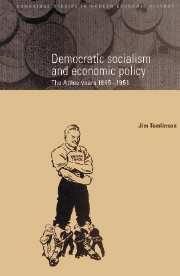Book contents
- Frontmatter
- Contents
- List of tables
- Acknowledgements
- List of abbreviations
- 1 Introduction: Labour and the economy 1900–1945
- 2 Labour and the international economy I: overall strategy
- 3 Labour and the international economy II: the balance of payments
- 4 Industrial modernisation
- 5 Nationalisation
- 6 Controls and planning
- 7 The financial system
- 8 Employment policy and the labour market
- 9 Labour and the woman worker
- 10 Towards a Keynesian policy?
- 11 The economics of the welfare state
- 12 Equality versus efficiency
- 13 Conclusions: political obstacles to economic reform
- Bibliography
- Index
1 - Introduction: Labour and the economy 1900–1945
Published online by Cambridge University Press: 09 November 2009
- Frontmatter
- Contents
- List of tables
- Acknowledgements
- List of abbreviations
- 1 Introduction: Labour and the economy 1900–1945
- 2 Labour and the international economy I: overall strategy
- 3 Labour and the international economy II: the balance of payments
- 4 Industrial modernisation
- 5 Nationalisation
- 6 Controls and planning
- 7 The financial system
- 8 Employment policy and the labour market
- 9 Labour and the woman worker
- 10 Towards a Keynesian policy?
- 11 The economics of the welfare state
- 12 Equality versus efficiency
- 13 Conclusions: political obstacles to economic reform
- Bibliography
- Index
Summary
Introduction
The Labour government of 1945–51 had to confront unprecedented economic problems, especially problems of the balance of payments, whilst at the same time attempting major reforms of the economy. How this task was managed, and the political and economic tensions it created, is the major theme of this book. Much recent writing has focused on the extent of consensus (benign or malignant according to taste) underlying policy in the 1940s. In contrast, this book concentrates on the relation between policy in this period and specifically Labour (or democratic socialist) ideas. The key concern is the interaction between such ideas and the constraints of actual policy-making.
The purpose of this introductory chapter is to put Labour's approach to the economy in 1945–51 into a longer-term perspective, by looking at the broad developments of its economic policy from the party's foundation (as the Labour Representation Committee) in 1900. The concluding chapter will, in similar vein, look at the political assumptions involved in economic policy-making in 1945–51 in the light of Labour's approach to politics.
A recent author has described the Labour leadership of the late 1920s as assuming ‘evolutionary change and the Webbian “inevitability of gradualness”: socialism would not murder capitalism but emerge from it. For them social justice and economic efficiency through organisation, co-ordination, and application of science were the hallmarks of the modern world’. This quotation aptly summarises much of Labour's approach to the economy, extending both before and after the 1920s.
- Type
- Chapter
- Information
- Democratic Socialism and Economic PolicyThe Attlee Years, 1945–1951, pp. 1 - 22Publisher: Cambridge University PressPrint publication year: 1996



